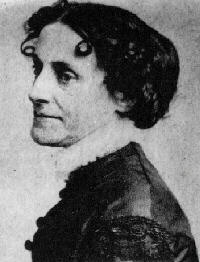Elizabeth Van Lew & Mary Elizabeth Bowser
By John T. Marck

Throughout the Civil War, many of the spies were slaves who were desperate for
the
North to
win, and thus secure their freedom. These slaves, both men and women, risked
their lives passing information on to the Union army. In addition to the slaves,
there was also a great deal of spying being done by well-to-do white women.
Women spying for either the North or the South used their large hoop skirts to
hide weapons, secret documents and other contraband, as well as other means.
Elizabeth Van Lew
(pictured at right) and her friend Mary Elizabeth Bowser, were prominent Union spies. Elizabeth was born in 1818, the daughter of wealthy Northern-born parents, who lived in Richmond. Siding with the North, she used her eccentric manner as a cover for her many espionage activities, which included assisting Union prisoners in escaping from Libby Prison, as well as providing clothes, medicine and food for them.
As the war continued, Elizabeth brought Mary Bowser, her mother and family servants into her spy ring. Mary Bowser, was a black slave, who was born in 1822 and worked in the Van Lew house until she was freed by her owners, and sent to Philadelphia for an education, paid for by the Van Lews. Returning to Richmond, she worked closely with Elizabeth in their espionage activities. At one time, Mary worked as a maid for President and Mrs. Jefferson Davis, enabling her to obtain Confederate secrets firsthand.
With the fall of Richmond, Elizabeth was visited by General Ulysses S. Grant, and speaking with her over a cup of tea on her porch replied, "You are the one person who has sent me the most useful information I have received from Richmond during the war."
After the war Elizabeth lived in her family's mansion in Richmond. Ostracized by society for her loyalty to the Union, she died in miserable poverty in 1900. Mary Elizabeth Bowser returned to the North, but no further details of her life are available.
Copyright
© 1990-2022 by John T. Marck. All Rights Reserved. This article and their accompanying pictures, photographs, and line art, may not be resold, reprinted, or redistributed for compensation of any kind without prior written permission from the author.

